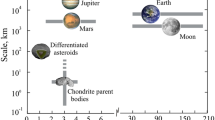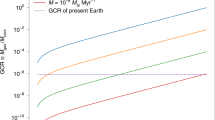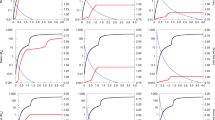Abstract
A hypothesis is proposed on the formation of the Earth and the Moon from a large-scale gas-dust cloud, the size of which is limited by the Hill radius, i.e., approximately one million kilometers. The compression of the supraplanetary gas-dust cloud resulted in an adiabatic temperature increase in its interior parts and evaporation of volatiles, including iron, from the surface of particles. At a certain stage, within 50–70 Ma after solar system formation, the supraplanetary gas-dust disk was fragmented, the Moon was separated, and the Earth embryo was formed. The remaining part of the gas-dust material was accreted mainly to the Earth. During this process, the gas dominated by primordial hydrogen was squeezed out of the disk. Vapor was removed together with hydrogen from the interparticle space. The hydrodynamic lifting resulted in the loss of volatiles, including Rb, Xe, and Pb, which is reflected in the Rb-Sr, Xe-I-Pu, and U-Pb isotopic systems. The gas-dust accretion was accomplished within 110–130 Ma (most likely, ∼120 Ma) after the beginning of solar system formation. Since then, the hydrodynamic lifting and volatile loss have ceased, and the history of the Earth as a condensed body has started.
Similar content being viewed by others
References
V. V. Adushkin, A. V. Vityazev, and G. V. Pechernikova, “Contribution to the Theory of the Origin and Evolution of the Earth,” in Problems of the Origin and Evolution of the Biosphere, Ed. by E. M. Galimov (URSS, Moscow, 2008), pp. 275–296 [in Russian].
C. Alibert, M. D. Norman, and M. T. McCulloch, “An Ancient Sm-Nd Age for a Ferroan Noritic Anorthosite Clast from Lunar Breccia 67016,” Geochim. Cosmochim. Acta 58, 2921–2926 (1994).
C. J. Allègre, G. Manhes, and C. Göpel, “The Age of the Earth,” Geochim. Cosmochim. Acta 59, 1445–1456 (1995).
C. J. Allègre, G. Manhes, and C. Göpel, “The Major Differentiation of the Earth at 4.45 Ga,” Earth Planet. Sci. Lett. 267, 368–398 (2008).
Y. Amelin, A. N. Krot, I. D. Hutcheon, and A. A. Ulyanov, “Pb Isotopic Ages of Chondrules and Ca, Al-Rich Inclusions,” Science 297, 1678–1683 (2002).
E. Anders and N. Grevesse, “Abundances of the Elements: Meteoritic and Solar,” Geochim. Cosmochim. Acta 53, 197–214 (1989).
E. Belbruno and J. R. Gott, “Where Did the Moon Come from?,” Astronom. J. 129, 1724–1745 (2005).
L. E. Borg, M. Norman, L. Nyquist, D. Bogard, G. Snyder, L. Taylor, and M. Lindstrom, “Isotopic Studies of Ferroan Anorthosite 62236: A Young Lunar Crustal Rock from a Light-Rare-Earth-Element Depleted Source,” Geochim. Cosmochim Acta 63, 2679–2691 (1999).
A. Bouvier, M. Wadhwa, and P. Janney, “Pb-Pb Isotope Systematics in an Allende Chondrule,” in Goldschmidt Conference Abstracts, Vancouver, Canada, 2008 (Vancouver, 2008), A104.
A. G. W. Cameron and W. Ward, “The Origin of the Moon,” Proc. 7th. Lunar. Conf. 120–122 (1976).
R. M. Canap, “Simulations of a Late Lunar Forming Impact,” Icarus 168, 433–456 (2004).
R. M. Canap and E. Asphaug, “Origin of the Moon in a Giant Impact near the End of the Earth’s Formation,” Nature 41(6848), 708–712 (2001).
R. M. Canap and L. W. Esposito, “Accretion of the Moon from an Impact-Generated Disk,” Icarus 119, 427–446 (1996).
R. W. Carlson and G. W. Lugmair, “The Age of Ferroan Anorthosite 60025: Oldest Crust on a Young Moon?” Earth Planet. Sci. Lett. 90, 119–130 (1988).
R. W. Carlson and G. W. Lugmair, “Timescales of Planetesimal Formation and Differentiation Based on Extinct and Extant Radioisotopes,” in “Origin of the Earth and Moon,” Ed. by R. M. Canap and K. Righter (Univ. Arizona, 2000), pp. 25–44.
J. E. Chambers, “Planetary Accretion in the Inner Solar System,” Earth Planet. Sci. Lett. 223, 241–252 (2004).
G. De Maria, G. Balducci, M. Guido, and V. Piacente, “Mass Spectrometric Investigation of the Vaporization Process of Apollo 12 Lunar Samples,” Proc. 2nd Lunar. Conf. 2, 1367–1380. (1971).
T. M. Eneev, “New Accumulation Model of Planet Formation and the Structure of the Outer Areas of the Solar System,” Preprint No. 166 (Inst. Prikl. Matem. Akad. Nauk SSSR, Moscow, 1979) [in Russian].
E. M. Galimov, “Several Consideration on the Early History of the Earth,” in From Mantle to Meteorites, Ed. by K. Gopalan et al., (Ind. Ac. Sci., Bangalore, 1990), pp. 177–188.
E. M. Galimov, “Problem of the Moon Origin,” in Main Directions in Geochemistry, Ed. by E. M. Galimov (URSS, Moscow, 1995) [in Russian].
E. M. Galimov, “On the Origin of Lunar Material,” Geokhimiya, No. 7, 691–706 (2004) [Geochem. Int. 43, 595–609 (2004)].
E. M. Galimov, “Present-Day State of the Problem of the Origin of the Earth-Moon System,” in Problems of the Origin and Evolution of the Biosphere Ed. by E. M. Galimov (URSS, Moscow, 2008) [in Russian].
E. M. Galimov, S. D. Kulikov, R. S. Kremnev, Yu. A. Surkov, and O. B. Khavroshkin, “The Russian Lunar Exploration Project,” Solar Syst. Res. 33(5), 327–337 (1999).
E. M. Galimov, A. M. Krivtsov, A. V. Zabrodin, et al., “Dynamic Model for the Formation of the Earth-Moon System,” Geokhimiya, No. 11, 1139–1150 (2005) [Geochem. Int. 43, 1045–1055 (2005)].
P. Goldreich and W. R. Ward, “The Formation of Planetesimals,” Astrophys. J. 183(3), 1057–1061 (1973).
N. Grevese and A. J. Sauval, “Standard Solar Composition,” in “Solar Composition and Evolution-from Core to Corona,” Ed. by C. Frohlich, M. C. E. Huber, and S. K. Solanki, Space Sci. Rev. 85, 161–174 (1998).
L. Grossman and J. W. Larimer, “Early Chemical History of the Solar System,” Rev. Geophys. Sp. Phys. 12, 71–101 (1974).
L. E. Gurevich and A. I. Lebedinskii, “Formation of Planets,” Izv. Akad. Nauk SSSR, Ser. Fiz. 14(6), 765–775 (1950).
K. E. Haisch, E. A. Loda, and C. L. Loda, “Disk Frequencies and Life-Times in Young Clusters,” Astrophys. J. 553, L153–L156 (2001).
A. N. Halliday, “A Young Moon-Forming Giant Impact at 70–110 Million Years Accompanied by Late-Stage Mixing, Core Formation and Degassing of the Earth,” Phil. Trans. R. Soc. London A366, 4163–4181 (2008).
A. N. Halliday and D.-C. Lee, “Tungsten Isotopes and the Early Development of the Earth and Moon,” Geochim. Cosmochim. Acta 63, 4157–4179 (1999).
A. N. Halliday and D. Porcelly, “In Search of Lost Planets-the Paleocosmochemistry of the Inner Solar System,” Earth Planet. Sci. Lett. 192, 545–559 (2001).
B. B. Hanan and G. R. Tilton, “60025: Relict of Primitive Lunar Crust?” Earth Planet. Sci. Lett. 84, 15–21 (1987).
A. W. Harris and A. Kaula, “Coaccretional Model of Satellite Formation,” Icarus 24, 516–524 (1975).
W. K. Hartmann and D. R. Davis, “Satellite-Sized Planetesimals and Lunar Origin,” Icarus 24, 504–515. (1975)
A. Hashimoto, “Evaporation Metamorphism in the Early Solar Nebula-Evaporation Experiments on the Melt FeO-MgO-SiO2-CaO-Al2O3 and Chemical Fractionations of Primitive Materials,” Geochem. J. 17, 111–145 (1983).
R. W. Hockney and J. W. Eastwood, Computer Simulation using Particles (Inst. Phys. Adam Hilger, Bristol, 1988).
M. F. Horan, M. L. Smoltar, and R. J. Walker, “W-182 and Re-187-Os-187 Systematics of Iron Meteorites: Chronology for Melting, Differentiation, and Crystallization in Asteroids,” Geochim. Cosmochim. Acta 62, 545–554 (1998).
M. Humayun and P. Cassen, “Processes Determining the Volatile Abundances of the Meteorites and Terrestrial Planets,” in Origin of the Earth and Moon, Ed. by R. M. Canap and K. Righter (Univ. Arizona, 2000), pp. 3–24.
M. Humayun and R. N. Clayton, “Precise Determination of the Isotopic Composition of Potassium: Application to Terrestrial Rocks and Lunar Soils,” Geochim. Cosmochim. Acta 59, 2115–2130 (1995).
D. M. Hunten, R. O. Pepin, and J. C. G. Walker, “Mass Fractionation in Hydrodynamic Escape,” Icarus 69, 532–549 (1987).
J. H. Jones and M. J. Drake “Geochemical Constraints on Core Formation in the Earth,” Nature 322, 221–228 (1986).
E. K. Kazenas and Yu. V. Tsvetkov, Thermodynamics of Oxide Evaporation (LKI, Moscow, 2008) [in Russian].
T. Kleine, H. Palme, K. Mezger, and A. N. Halliday, “Hf-W Chronology of Lunar Metal and the Age and Early Differentiation of the Moon,” Science 310, 1671–1674 (2005).
T. Kleine, M. Touboul, J. A. Van Orman, B. Bourdon, C. Maden, K. Mezger, and A. N. Halliday, “Hf-W Thermochronometry: Closure Temperature and Constraints on the Accretion and Cooling History of H Chondrites Parent Body,” Earth Planet. Sci. Lett. 270, 106–118 (2008).
T. Kleine, M. Touboul, C. Burkhardt, and B. Bourdon, “Dating the First ∼100 Ma of the Solar System: From the Formation of CAIs to the Origin of the Moon,” in Goldschmidt Conference Abstracts, Vancouver, Canada, 2008 (Vancouver, 2008a), A480.
T. Kleine, M. Touboul, B. Bourdon, F. Nimmo, K. Mezger, N. Palme, S. Jacobsen, Q.-Z. Yin, and A. N. Halliday, “Hf-W Chronology of the Accretion and Early Evolution of Asteroids and Terrestrial Planets,” Geochim. Cosmochim. Acta 73, 5150–5188 (2009).
A. V. Kolesnichenko and M. Ya. Marov, “Fundamentals of the Mechanics of Heterogeneous Media in the Circumsolar Protoplanetary Cloud: The Effects of Solid Particles on Disk Turbulence,” Astron. Vestn. 40(1), 2–62 (2006) [Solar Syst. Res. 40 (1), 1–56 (2006)].
N. N. Kozlov and T. M. Eneev, “Numerical Modeling of the Formation of Planets from a Protoplanetary Cloud,” Preprint No. 134 (Inst. Prikl. Matem. Akad. Nauk SSSR, Moscow, 1977) [in Russian].
A. M. Krivtsov and N. V. Krivtsova, “Particle Method and Its Use in the Mechanics of Deformable Solids,” Dal’nevost. Matem. Zh. 3(2), 254–276 (2002).
E. Kurahashi, N. T. Kita, H. Nagahara, and Y. Morishita, “26Al-26Mg Systematics and Petrological Study of Chondrules in CR Chondrites,” in Goldschmidt Conference Abstracts, Vancouver, Canada, 2008 (Vancouver, 2008) A504.
O. L. Kuskov and V. A. Kronrod, “Bulk Composition and Sizes of the Lunar Core,” in Problems of the Origin and Evolution of the Biosphere, Ed. by E. M. Galimov (URSS, Moscow, 2008), pp. 317–327 [in Russian].)
J. W. Larimer, “The Condensation and Fractionation of Refractory Lithophile Elements,” Icarus 40, 446–454 (1979).
J. W. Larimer, “Nebular Chemistry and Theories of Lunar Origin,” in Origin of the Moon, Ed. by W. K. Hartman, R. J. Phillips, and G. J. Taylor (Lunar Planet. Inst., Houston, 1986), pp. 145–171.
A. A. Le-Zakharov and A. M. Krivtsov, “Algorithm for Calculation of the Collisional Dynamics of Gravitating Particles for the Simulation of the Earth-Moon System Formation Due to the Gravitational Collapse of a Dust Cloud,” in Problems of the Origin and Evolution of the Biosphere, Ed. by E. M. Galimov (URSS, Moscow, 2008), pp. 329–344 [in Russian].
D.-C. Lee and A. N. Halliday, “Hafnium-Tungsten Chronometry and the Timing of Terrestrial Core Formation,” Nature 378, 771–774 (1995).
D.-C. Lee, A. N. Halliday, G. A. Snyder, and L. A. Taylor, “Age and Origin of the Moon,” Science 278, 1098–1103 (1997).
I. Leya, W. Rainer, and A. N. Halliday, “Cosmic-Ray Production of Tungsten Isotopes in Lunar Samples and Meteorites and Its Implications for Hf-W Cosmochemistry,” Earth Planet. Sci. Lett. 175, 1–12 (2000).
O. M. Markova, O. I. Yakovlev, G. L. Semenov, and A. N. Belov, “Some General Experimental Results on Natural Melt Evaporation in the Knudsen Cell,” Geokhimiya, No. 11, 1559–1569 (1986).
M. Ya. Marov, A. V. Kolesnichenko, A. B. Makalkin, et al., “From Protosolar Cloud to the Planetary System: Model of the Evolution of a Gas-Dust Disk,” in Problems of the Origin and Evolution of the Biosphere, Ed. by E. M. Galimov (URSS, Moscow, 2008), pp. 223–273 [in Russian].
M. T. McCulloch, “Primitive 87Sr/86Sr from an Archean Barite and Conjecture on the Earth’s Age and Origin,” Earth Planet. Sci. Lett. 126, 1–13 (1994).
H. J. Melosh, “A New and Improved Equation of State for Impact Computations,” Proc. 31st Lunar Planet. Conf., 1903 (2000).
Y. Nakamura, “Seismic Velocity Structure of the Lunar Mantle,” J. Geophys. Res. 88, 677–686 (1983).
H. E. Newsom, “Constraints on the Origin of the Moon from Abundance of Molybdenum and Other Siderophile Elements,” in Origin of the Moon, Ed. by W. K. Hartman, R. J. Phillips, and G. J. Taylor (Lunar Planet. Inst., Huoston, 1986), pp. 203–230.
M. D. Norman, E. Borg, L. E. Nyquist, and D. D. Bogard, “Chronology, Geochemistry, and Petrology of a Ferroan Noritic Anorthosite Clast from Descartes Breccia 67215: Clues to the Age, Origin, Structure, and Impact History of the Lunar Crust,” Meteor. Planet. Sci. 38, 645–661 (2003).
L. E. Nyquist and C.-Y. Shih, “The Isotopic Record of Lunar Volcanism,” Geochim. Cosmochim. Acta 56, 2213–2234 (1992).
H. St. C. O’Neill, “The Origin of the Moon and the Early History of the Earth-A Chemical Model. Part 1: The Moon,” Geochim. Cosmochim. Acta 55, 1135–1157 (1991).
K. Pahlevan and D. J. Stevenson, “Volatile Loss Following the Moon-Forming Giant Impact,” in Goldschmidt Conference Abstracts, Vancouver, Canada, 2008 (Vancouver, 2008), A716.
F. A. Podosek and P. Cassen, “Theoretical, Observational, and Isotopic Estimates of the Lifetime of the Solar Nebula,” Meteoritics 29, 6–25 (1994).
F. A. Podosek and M. Ozima, “The Xenon Age of the Earth,” in Origin of the Earth and Moon, Ed. by R. M. Canap and K. Righter (Univ. Arizona, 2000), pp. 63–74.
F. Poitrasson, “Does Planetary Differentiation Really Fractionate Iron Isotopes?” Earth Planet. Sci. Lett. 223, 484–492 (2007).
F. Poitrasson, A. N. Halliday, D. C. Lee, S. Levasseur, and N. Teutsch, “Iron Isotope Differences between Earth, Moon, Mars and Vesta as Possible Records of Contrasted Accretion Mechanisms,” Earth Planet. Sci. Lett. 223, 253–266 (2004)
D. Porcelli, D. Woollum, and P. Cassen, “Deep Earth Rare Gases: Initial Inventories, Capture from the Solar Nebula, and Losses during Moon Formation,” Earth Planet. Sci. Lett. 193, 237–251 (2001).
K. Righter, K. M. Pando, L. Danielson, and C.-T. Lee, “Partitioning of Mo, P, and Other Siderophile Elements (Cu, Ga, Sn, Ni, Co, Cr, Mn, V, and W) between Metal and Silicate Melt as a Function of Temperature and Silicate Melt Composition,” Earth Planet. Sci. Lett. 291, 1–9 (2010).
A. E. Ringwood, “Composition and Origin of the Moon,” in “Origin of the Moon,” Ed. by W. K. Hartmann et al. (Lunar Planet. Inst., Houston, 1986), pp. 673–698.
V. S. Safronov, Evolution of the Protoplanetary Cloud and Formation of the Earth and Planets (Moscow, Nauka, 1969) [in Russian].
R. Schoenberg, B. S. Kamber, K. D. Collerson, and O. Eugster, “New W-Isotope Evidence for Rapid Terrestrial Accretion and Very Early Core Formation,” Geochim. Cosmochim. Acta 66, 3151–3160 (2002).
C.-Y. Shih, L. E. Nyquist, E. J. Dasch, D. D. Bogard, B. M. Bansal, and H. Wiesmann, “Age of Pristine Noritic Clasts from Lunar Breccias 15445 and 15455,” Geochim. Cosmochim. Acta 57, 915–931 (1993).
G. R. Stewart and W. M. Kaula, “A Gravitational Kinetic Theory for Planetesimales,” Icarus 24, 516–524 (1980)
D. Stevenson, “Earth Formation: Combining Physical Models with Isotopic and Elemental Constraints,” Geochim. Cosmochim. Acta, 15th Goldshmidt Conference Abstract Volume, A382 (2005).
T. D. Swindle and F. A. Podosek, “Iodine-Xenon Dating,” in Meteorites and the Early Solar System, Ed. by J. F. Kerridge and M. S. Matthews (Univ. Arizona, Tucson, 1988), pp. 1127–1146 (1988).
S. R. Taylor, “The Origin of the Moon: Geochemical Consideration,” in Origin of the Moon, Ed. by W. K. Hartmann, R. J. Phillips, and G. J. Taylor (Lunar Planet. Inst., Houston, 1986), pp. 125–144.
F. Tera, D. A. Papanastassiou, and G. J. Wasserburg, “A Lunar Cataclysm at ∼3.95 AE and the Structure of the Lunar Crust,” Proc. 4th Lunar. Conf., 723–725 (1973).
M. Touboul, T. Kleine, B. Bourdon, H. Palme, and R. Wieler, “Late Formation and Prolonged Differentiation of the Moon Inferred from W Isotopes in Lunar Metals,” Nature 450, 1206–1209 (2007).
S. V. Vasilyev, A. M. Krivtsov, and E. M. Galimov, “Modeling Space Bodies Growth by Accumulation of Space Dust Material,” in Proc. 32nd Summer School-Conference Advanced Problem in Mechanics, St. Petersburg. Russia, 2004 (St. Petersburg, 2004), pp. 425–428.
A. V. Vityazev, G. V. Pechernikova, and V. S. Safronov, Terrestrial Planets: Origin and Early Evolution (Nauka, Moscow, 1990) [in Russian].
J. Wang, A. M. Davis, R. N. Clayton, and A. Hashimoto, “Evaporation of Single Crystal Forsterite: Evaporation Kinetics, Magnesium Isotope Fractionation and Implication of Mass-Dependent Isotopic Fractionation of Mass-Controlled Reservoir,” Geochim. Cosmochim. Acta 63, 953–966 (1999).
H. Wanke and G. Dreibus, “Geochemical Evidence for the Formation of the Moon by Impact-Induced Fission of the Proto-Earth,” in Origin of the Moon, Ed by W. K. Hartman et al. (Lunar Planet. Inst., Houston, 1986), pp. 649–672.
S. Weyer, A. D. Anbar, G. P. Brey, C. Munker, K. Mezger, and A. B. Woodland, “Iron Isotope Fractionation during Planetary Differentiation,” Earth Planet. Sci. Lett. 240, 251–264 (2005).
G. W. Wetherill, “Formation of the Terrestrial Planets,” Annu. Rev. Astron. Astrophys. 18, 77–113 (1980)
G. W. Wetherill and L. P. Cox, “The Range of Validity of the Two-Body Approximation in Models of Terrestrial Planet Accumulation,” Icarus 63, 290–303 (1985).
H. M. Williams, A. Markowski, G. Quitté, A. N. Halliday, N. Teutsch, and S. Levasseur, “Fe Isotope Fractionation in Iron Meteorites: New Insights into Metal-Sulphide Segregation and Planetary Accretion,” Earth Planet. Sci. Lett. 250, 486–500 (2006).
B. J. Wood, J. Wade, and M. R. Kilburn, “Core Formation and the Oxidation State of the Earth: Additional Constraints from Nb, V and Cr Partitioning,” Geochim. Cosmochim. Acta 72, 1415–1426 (2008).
Q. Yin, S. B. Jacobsen, K. Yamashita, J. Blichert-Toff, P. Telouk, and F. Albarede, “A Short Timescale for Terrestrial Planet Formation from Hf-W Chronometry of Meteorites,” Nature 418, 949–952 (2002).
A. V. Zabrodin, E. A. Zabrodina, M. S. Legkostupov, et al., “Some Descriptive Models of the Protoplanetary Disk of the Sun at the Initial Stage of its Evolution,” in Problems of the Origin and Evolution of the Biosphere, Ed. by E. M. Galimov (URSS, Moscow, 2008), pp. 297–315 [in Russian].
Author information
Authors and Affiliations
Corresponding author
Additional information
Original Russian Text © E.M. Galimov, 2011, published in Geokhimiya, 2011, Vol. 49, No. 6, pp. 563–580.
Rights and permissions
About this article
Cite this article
Galimov, E.M. Formation of the Moon and the Earth from a common supraplanetary gas-dust cloud (lecture presented at the XIX all-Russia symposium on isotope geochemistry on November 16, 2010). Geochem. Int. 49, 537–554 (2011). https://doi.org/10.1134/S0016702911060048
Received:
Published:
Issue Date:
DOI: https://doi.org/10.1134/S0016702911060048




